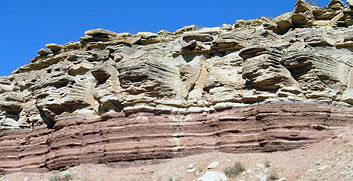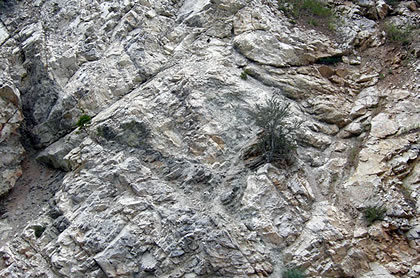 There are three main types of rock on Earth: igneous, sedimentary and metamorphic.
There are three main types of rock on Earth: igneous, sedimentary and metamorphic.
Sedimentary rock covers about three quarters of the land on the Earth's surface. However, sedimentary rock makes up only about 5 percent of the top 10 miles (16 kilometers) of the Earth's crust. The other 95 percent consists of igneous and metamorphic rocks.
Sedimentary rock is the softest of the three types of rock. Therefore, it is the quickest to erode.
Igneous Rocks
Igneous rocks are made from magma – molten rock. The word “igneous” comes from the Latin word for "fire".
As magma cools, it solidifies. During this process, the minerals in the magma harden in a predictable sequence.
The first to crystallize are the olivines and the pyroxenes – silicates (silicon compounds) of magnesium and iron. These minerals tend to be denser than the other components of the magma, so they sink out of the mixture.
Silicates of potassium, sodium, calcium and aluminum (lighter metals) – the feldspars solidify next.
Finally, any remaining silica (silicon dioxide) crystallizes and becomes quartz.
Igneous rocks with low silica content are known as basic rocks. These rocks usually have a large amount of iron and magnesium. Basic rocks, such as gabbro, are usually dark colored.
Acidic rocks have a low silica content. They consist of white and pink feldspars and glassy quartz, and are therefore usually light-colored.
The composition of igneous rocks is affected by how slowly or quickly the magma that forms it cools.
The rate at which magma cools affects the composition of the igneous rocks that form from it.
Igneous rocks that form below the Earth’s surface cool slowly. These rocks are known as intrusive igneous rocks. Examples of intrusive igneous rocks are gabbro and granite. This type of rock has large crystals.
The majority of igneous rocks form far below the Earth’s surface in structures known as intrusions. These can eventually form impressive aboveground structures. Batholiths, which form deep beneath the surface, are the largest intrusions. The Sierra Nevada mountain range in California was formed from a batholith.
If an underground crack fills with magma, a sheet of igneous rocks will form when the magma solidifies. If this sheet lies parallel to the surrounding rock layers, it is known as a sill. If it runs across the layers, it is called a dike.
Magma can sometimes cool quickly. This happens after a volcano erupts and the magma appears on the Earth’s surface as magma. The lava solidifies to form extrusive igneous rocks. These rocks are fine-grained and have small crystals or, in the case of obsidian, no visible crystals at all. Obsidian looks like glass.
There are igneous rocks that have both large and small crystals. A two-textured rock of this type is known as a porphyritic rock. Rocks develop porphyritic textures because the speed at which the magma solidifies changes while the rock is hardening. This can happen if the rock moves to a cooler location.
Movements of tectonic plates can force rocks back into Earth, where they melt again. This newly formed magma may rise to the surface through volcanoes again. Thus, igneous rocks are constantly being formed from old rocks.
Sedimentary Rocks
The rocks on the Earth’s surface are constantly subject to erosion.
When rocks erode, they break down into loose material that is known as sediment.
Rivers, glaciers and wind carry sediment long distances.
 When sediment eventually comes to rest- usually in water, it accumulates in layers.
When sediment eventually comes to rest- usually in water, it accumulates in layers.
In a process known as lithification, these layers become compacted and chemically cemented together, forming sedimentary rock.
Sometimes, movements of the Earth will cause sedimentary rocks to become uplifted. When this happens, the lower layers become exposed to the environment. Eventually, they erode and form sediment. Eventually, this sediment becomes new sedimentary rock.
The entire process of erosion and the formation of sedimentary rock is known as the sedimentary cycle.
The composition of sedimentary rocks varies greatly.
Some sedimentary rocks contain large pebbles. These rocks are known as conglomerates.
Shales are made up of tiny particles of silt and clay.
Sandstones are composed of sand grains.
Some sedimentary rocks, such as limestone, which is made of calcite (calcium carbonate) and coal, contain the remains of living things.
Fossils can be found in sedimentary rocks. Paleontologists can determine the age of fossils by examining where they are positioned within rock layers.
Geologists can look at sedimentary rocks to find out what conditions on Earth were like at particular times during our planet’s history.
Coal
Coal is a sedimentary rock made from ancient plant matter.
It is made mostly of carbon – the main component of organic matter. It also contains nitrogen, oxygen, hydrogen and sulfur.
Hundreds of millions of years ago, during the Carboniferous ("coal-bearing") era, oceans were wide and shallow.
Giant ferns grew in bogs that were often many miles across.
Every year these ferns would drop their leaves.
Beds of dead leaves and trees formed in the bogs. These dark brown beds, known as peat, grew to be many feet thick.
Throughout the Earth's history, the oceans have repeatedly flowed over dry land and then receded.
Each time water has covered the land, it has left behind sediment.
Over time, peat became covered with sediment. The weight of the sediment crushed it, dried it out and darkened it. Eventually, the peat was transformed into the brownish-black substance we know as coal.
When the oceans receded, peat would accumulate once more.
Eventually, layers of coal alternated with layers of sediments washed in from the ocean. These layers of coal are known as coal beds.
Some harder forms of coal, such as anthracite coal, are formed when coal is exposed to high temperatures and pressures. Therefore, these types of coal can be considered metamorphic rocks.
Metamorphic Rocks
A rock that has undergone a change in its composition as the result of pressure, heat or chemical action is known as a metamorphic rock.
Rocks have been altered as the result of enormous pressure but little heat are known as regional, or dynamic, metamorphic rocks.
When shale that is buried deep beneath the Earth withstands great pressure, its minerals recrystallize to form mica. The movements of the Earth can then deform the mica so that it forms a type of regional metamorphic rock known as a schist.
When rocks on each side of a major fault move against each other, dislocation metamamorphism takes place. Stress on the rocks at the fault causes their minerals to recrystallize, giving rise to a hard, flinty metamorphic rock known as mylonite.
Rocks that have been changed by extreme heat but little pressure are known as thermal (or contact) metamorphic rocks.
When magma forces its way through the Earth’s crust, it bakes the rocks around it.
 Marble is a thermal metamorphic rock that forms from limestone – a sedimentary rock.
Marble is a thermal metamorphic rock that forms from limestone – a sedimentary rock.
When limestone is heated by a nearby igneous intrusion, it gives off carbon dioxide. Later, the limestone recombines with the carbon dioxide, forming new calcite crystals that have a regular structure and grain size. The newly formed rock – marble - is therefore stronger and more evenly textured than limestone.
Metasomatism, the creation of metamorphic rock as the result of chemical changes, is often associated with thermal metamorphism. As an igneous mass cools, it gives off hot liquids and gases, which may percolate through cracks and cavities in the surrounding rock. The heat created, as well as chemicals in the liquids and gases, can alter the composition of the surrounding rock.